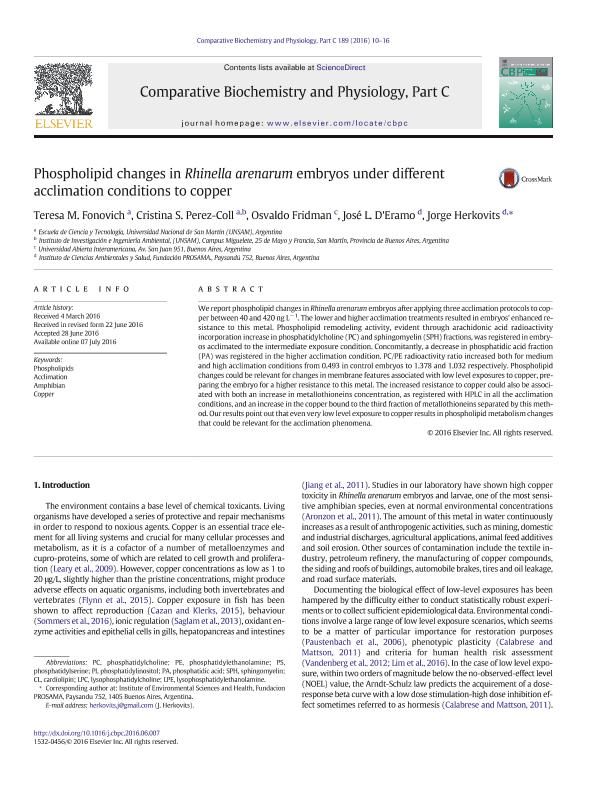Mostrar el registro sencillo del ítem
dc.contributor.author
Fonovich, Teresa Mabel

dc.contributor.author
Perez Coll, Cristina Silvia

dc.contributor.author
Fridman, Osvaldo

dc.contributor.author
D'eramo, Jose Luis

dc.contributor.author
Herkovits, Jorge

dc.date.available
2018-05-31T15:20:14Z
dc.date.issued
2016-11
dc.identifier.citation
Fonovich, Teresa Mabel; Perez Coll, Cristina Silvia; Fridman, Osvaldo; D'eramo, Jose Luis; Herkovits, Jorge; Phospholipid changes in Rhinella arenarum embryos under different acclimation conditions to copper; Elsevier Science Inc; Comparative Biochemistry And Physiology. Toxicology & Pharmacology; 189; 11-2016; 10-16
dc.identifier.issn
1532-0456
dc.identifier.uri
http://hdl.handle.net/11336/46801
dc.description.abstract
We report phospholipid changes in Rhinella arenarum embryos after applying three acclimation protocols to copper between 40 and 420 ng L− 1. The lower and higher acclimation treatments resulted in embryos' enhanced resistance to this metal. Phospholipid remodeling activity, evident through arachidonic acid radioactivity incorporation increase in phosphatidylcholine (PC) and sphingomyelin (SPH) fractions, was registered in embryos acclimated to the intermediate exposure condition. Concomitantly, a decrease in phosphatidic acid fraction (PA) was registered in the higher acclimation condition. PC/PE radioactivity ratio increased both for medium and high acclimation conditions from 0.493 in control embryos to 1.378 and 1.032 respectively. Phospholipid changes could be relevant for changes in membrane features associated with low level exposures to copper, preparing the embryo for a higher resistance to this metal. The increased resistance to copper could also be associated with both an increase in metallothioneins concentration, as registered with HPLC in all the acclimation conditions, and an increase in the copper bound to the third fraction of metallothioneins separated by this method. Our results point out that even very low level exposure to copper results in phospholipid metabolism changes that could be relevant for the acclimation phenomena.
dc.format
application/pdf
dc.language.iso
eng
dc.publisher
Elsevier Science Inc

dc.rights
info:eu-repo/semantics/openAccess
dc.rights.uri
https://creativecommons.org/licenses/by-nc-nd/2.5/ar/
dc.subject
Phospholipids
dc.subject
Acclimation
dc.subject
Amphibian
dc.subject
Copper
dc.subject.classification
Otras Ciencias Químicas

dc.subject.classification
Ciencias Químicas

dc.subject.classification
CIENCIAS NATURALES Y EXACTAS

dc.title
Phospholipid changes in Rhinella arenarum embryos under different acclimation conditions to copper
dc.type
info:eu-repo/semantics/article
dc.type
info:ar-repo/semantics/artículo
dc.type
info:eu-repo/semantics/publishedVersion
dc.date.updated
2018-05-30T14:29:24Z
dc.journal.volume
189
dc.journal.pagination
10-16
dc.journal.pais
Estados Unidos

dc.description.fil
Fil: Fonovich, Teresa Mabel. Universidad Nacional de San Martín. Escuela de Ciencia y Tecnología; Argentina
dc.description.fil
Fil: Perez Coll, Cristina Silvia. Universidad Nacional de San Martín. Escuela de Ciencia y Tecnología; Argentina. Universidad Nacional de San Martín. Instituto de Investigación e Ingeniería Ambiental; Argentina. Consejo Nacional de Investigaciones Científicas y Técnicas; Argentina
dc.description.fil
Fil: Fridman, Osvaldo. Universidad Abierta Interamericana; Argentina. Consejo Nacional de Investigaciones Científicas y Técnicas; Argentina
dc.description.fil
Fil: D'eramo, Jose Luis. Fundación Pro Salud y Medio Ambiente. Instituto de Ciencias Ambientales y Salud; Argentina. Consejo Nacional de Investigaciones Científicas y Técnicas; Argentina
dc.description.fil
Fil: Herkovits, Jorge. Fundación Pro Salud y Medio Ambiente. Instituto de Ciencias Ambientales y Salud; Argentina. Consejo Nacional de Investigaciones Científicas y Técnicas; Argentina
dc.journal.title
Comparative Biochemistry And Physiology. Toxicology & Pharmacology

dc.relation.alternativeid
info:eu-repo/semantics/altIdentifier/doi/https://dx.doi.org/10.1016/j.cbpc.2016.06.007
dc.relation.alternativeid
info:eu-repo/semantics/altIdentifier/url/https://www.sciencedirect.com/science/article/pii/S1532045616300722
Archivos asociados
